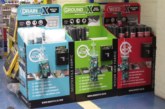
With the Brexit transition period having ended on 31 December, merchants now have to contend with the new UKCA and UKNI product marks — however, there is still confusion around where the new product marking system applies, the role merchants have to play in upholding it, and how existing stocks of door opening hardware are affected. Richard Bromley, Business Development Director at UNION (part of the ASSA ABLOY Door Hardware Group), explains.
Every business in the door hardware supply chain has a role and responsibility around the new product marking system. Affecting locks, hinges, panic exit devices and door closers in addition to electro-mechanical locking solutions, it is essential that merchants stocking these products understand the implications of these changes.
The EU Construction Product Regulations are used to harmonise technical standards across EU member states, ensuring that goods sold in the EU meet certain health, safety and performance standards. As a result of Brexit, the UK is no longer part of these regulations, with a new parallel product marking system set up in its place.
This has seen the introduction of new marks, including the UKCA (UK Conformity Assessed) and UKNI, and approved bodies. But what does the new product marking system state and what do the UKCA and UKNI cover?
Understanding the UKCA and UKNI
The UKCA mark will be used for goods being placed on the market in England, Scotland and Wales. It covers all goods that previously required the CE marking.
Since 1 January 2021, all new products launched in Great Britain should be UKCA marked, with the CE mark no longer being recognised in the UK from 1 January 2022. For current CE marked products, there will be a ‘coexistence’ period until 31st December 2021 where these goods can continue to be sold in Great Britain. Please be aware that some CE mark certification and notified body numbers may change, as accreditation is transferred to a European-based notified body.
During this timeframe, it is expected that manufacturers will take steps to ensure existing CE marked products will have the UKCA mark applied in time for 1 January 2022, when the CE mark will cease to be recognised in Great Britian. The new UKCA mark should appear on the product where possible, as well as on packaging and literature.
UKCA marking must be undertaken by a UK-recognised ‘approved body’. An EU notified body, which would previously have been called upon for CE marking, cannot be used for UKCA marking.
Many manufacturers export to the Republic of Ireland and elsewhere in Europe, and so will continue to CE mark goods. In many instances, the new endorsements will appear alongside CE mark details, which helps protect merchants selling to international customers, too.
Coming into effect on 1 January 2021, the use of the UKNI mark aims to prevent a hard border between Northern Ireland and the Republic of Ireland by ensuring that the province will continue to follow the EU’s rules on product standards.
Critically, CE marking can continue to be used in Northern Ireland after 1 January 2021, to demonstrate products still meet EU standards. However, if a manufacturer uses a UK approved body — rather than an EU notified body — to carry out mandatory third-party assessments, then products must also carry the new UKNI mark as well as the CE mark.
Are merchants up to the mark?
Understanding the new rules and regulations surrounding the UKCA and UKNI marks can be onerous for builders’ merchants. Nevertheless, it is everyone’s responsibility, throughout the supply chain, to ensure that properly certified and marked products are specified to suit the end application. While it is the manufacturer’s responsibility to ensure their products conform to the standards, it is the final reseller’s responsibility to ensure the products they stock and sell are fit for purpose.
For instance, hardware covered by an EU harmonised standard being fitted onto a fire door must be appropriately marked. Therefore, if a product that does not conform is sold by a builders’ merchant to a customer — such as a non-marked hinge ending up on a fire door — then there could be a thorough investigation, as well as potentially significant fines and penalties to face.
Therefore, it is critical that merchants have a solid understanding of what the correct product marking entails and the timescales that are being worked towards. If in any doubt on the final application, merchants should sell marked hardware, whether that’s the CE, UKCA or UKNI mark.
 UNION and product marking
UNION and product marking
In response to the recent changes, UNION is taking the essential steps so that merchants can have complete confidence in its fire door hardware products, ensuring they have undergone the correct third-party marking for goods being sold into either Great Britain or Northern Ireland.
From the beginning of 2021 for Great Britain, all of UNION’s new products will be certified using a UK approved body and have the UKCA mark applied, if they are intended to be used on fire doors or if it is electro-mechanical hardware. For its range of existing CE marked products, the company is progressing UKCA marking for these solutions too, ensuring they are properly certified and marked in time for the 1 January 2022 deadline.
In Northern Ireland, for existing door hardware solutions that are CE marked by a UK-based notified body, UNION has transferred certification to or has re-certified products with an EU-based notified body.
Then, all new products sold into Northern Ireland are now either CE marked by an EU-based notified body, or a UK-based approved body is being used to gain UKNI marking, alongside the UK-registered CE mark approval.
And, finally, no matter where in the UK products are being sold, all relevant documents, such as labels, product packaging, marketing materials and instruction manuals, are being updated accordingly too. Clearly, this is no small feat, and this will be a rolling change throughout the year. Please be reassured that goods already manufactured and in the supply chain remain perfectly legal to sell during this transition period.
Ensuring compliance
It’s worth repeating that if a builders’ merchant is unsure about the final application for a product, then marked hardware must be sold. While door hardware manufacturers are responsible for making sure products conform, merchant stockists must play their role in ensuring the door hardware they are selling meets the relevant product marks.
By taking these steps, all businesses throughout the door hardware supply chain can ensure that they can make the most of the opportunities available in this new chapter of the UK’s history. If everyone does their due diligence, electro-mechanical solutions, fire door products, panic exit devices, door hinges and closers will all meet the health, safety and performance standards that they are meant to.
To find out more about ASSA ABLOY Opening Solutions UK & Ireland, go to:









